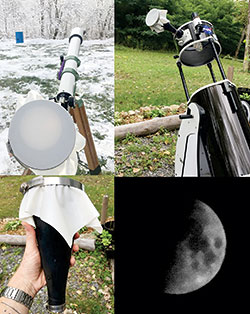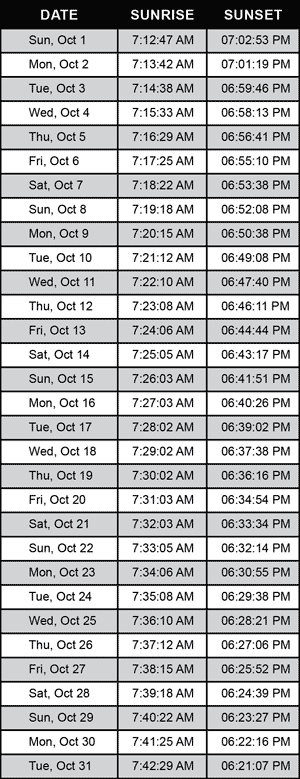|
|
DARK SKY HAPPENINGS - October 2023
Moab
UT (at City Hall)
38O34’ N Latitude
109O33’ W Longitude
4048 ft - 1234 m |
Weird Ways to Observe the Moon
Adapted from an article by David Prosper
 International Observe the Moon Night is on October 21 this year– but you can observe the Moon whenever it’s up, day or night! While binoculars and telescopes certainly reveal incredible details of our neighbor’s surface, bringing out dark seas, bright craters, and numerous odd fissures and cracks, there are more ways to observe the Moon than you might expect! International Observe the Moon Night is on October 21 this year– but you can observe the Moon whenever it’s up, day or night! While binoculars and telescopes certainly reveal incredible details of our neighbor’s surface, bringing out dark seas, bright craters, and numerous odd fissures and cracks, there are more ways to observe the Moon than you might expect!
Put on a pair of sunglasses, especially polarized sunglasses! You may think this is a joke, but polarized sunglasses dramatically reduce glare, and so they allow your eyes to pick out some lunar details! Surprisingly, wearing sunglasses even helps during daytime observations of the Moon.
Another unlikely tool is the humble plastic bottle cap! John Goss from the Roanoke Valley Astronomical Society shared directions on how to make your own bottle cap lunar viewer, which was suggested to him by Fred Schaaf:
1. Start by drilling a round 1/16-inch (1.5 mm) diameter hole in a soft plastic bottle cap. Make sure it is unobstructed.
2. Now look through the hole at the bright Moon. The image brightness will be much dimmer, reducing glare and revealing lunar detail!
You can project the Moon! Have you heard of a “sun funnel”? It’s a way to safely view the Sun by projecting the image from the eyepiece of a telescope to fabric stretched across a funnel mounted on top. It’s easy to make at home, too– bit.ly/sunfunnel. Depending on your equipment, a Sun Funnel can view the Moon as well as the Sun– a full Moon gives off more than enough light to project from even relatively small telescopes!
Of course, you can join folks in person or online on October 21 for International Observe the Moon Night– find details at https://moon.nasa.gov/observe-the-moon-night. You may also want to consider a solar funnel to observe the Sun on October 14 when an annular eclipse will be visible in the Moab area. It is never safe to look directly at the sun during an annular eclipse, so learn how to enjoy one safely from NASA: https://solarsystem.nasa.gov/eclipses/2023/oct-14-annular/overview.
Sun Funnels in action! Starting clockwise from the bottom left, a standalone Sun Funnel; attached to a small refractor to observe the transit of Mercury in 2019; attached to a large telescope in preparation for evening lunar observing; projection of the Moon onto a funnel from a medium-size scope (5 inches).
Safety tip: NEVER use a large telescope with a Sun Funnel to observe the Sun, as they are designed to project the Sun using small telescopes only. Some eager astronomers have melted their Sun Funnels, and parts of their own telescopes, by pointing them at the Sun - large telescopes create far too much heat, sometimes within seconds! However, large instruments are safe and ideal for projecting the much dimmer Moon. Small telescopes can’t gather enough light to decently project the Moon, but larger scopes will work.
|
Sunrise-Sunset
(The time of sunrise and sunset assumes a flat horizon. Actual time may
vary depending upon the landscape.) |
 |
MOON HAPPENINGS
October 6 - Third Quarter at 7:47 am October 14 - New Moon at 11:55 am October 21 - First Quarter at 9:29 pm October 28 - Full Moon at 2:24 pm
|
Moab Dark Skies mission is to promote the appreciation and conservation of Moab’s valuable and rare dark skies. Moab Dark Skies was established by the Friends of Arches and Canyonlands Parks in conjunction with the National Park Service and Utah State Parks Division of Natural Resources
For more information, check out our
Facebook page |
|
|
|
|
|
|
|
© 2002-2024 Moab Happenings. All rights
reserved.
Reproduction of information contained in this site is
expressly prohibited.
|
|